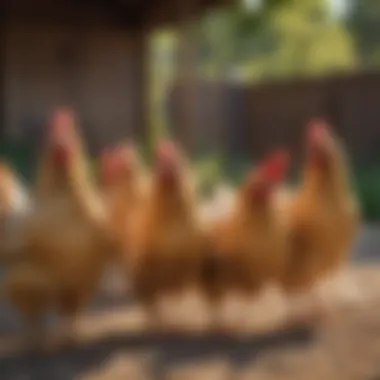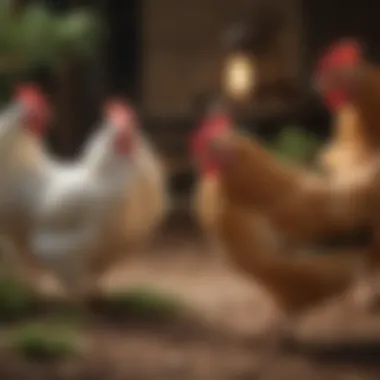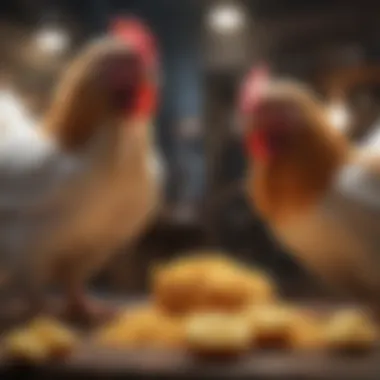Understanding Buff Orpington Chickens: A Complete Guide


Intro
Buff Orpington chickens hold a distinguished place in the world of poultry. Known for their gentle temperament and resilience, they are often a preferred choice for both new and experienceed chicken owners. Their versatility makes them ideal for various environments, ranging from spacious homesteads to compact urban backyards. In this comprehensive guide, we will explore the key aspects of raising Buff Orpington chickens. This includes their grooming needs, health and wellness, training, and other factors that ensure a successful chicken-keeping experience.
Grooming Techniques
Grooming Buff Orpingtons is essential for their health and happiness. Their soft, fluffy feathers require some attention, but fortunately, the process is quite straightforward.
Basic Grooming Tools
Equipping yourself with the right tools is crucial. Essential grooming tools for Buff Orpington chickens include:
- Comb: Used for detangling feathers.
- Brush: A soft-bristled brush helps remove dirt and debris without damaging their feathers.
- Nail Clippers: Keeping nails trimmed is a vital part of health care.
- Hygiene Spray: Useful for pest control and maintaining clean feathers.
Step-by-Step Grooming Guides
- Brushing: Begin by carefully brushing the feathers in the direction of growth. This helps remove loose feathers and dirt.
- Inspecting: Look for any signs of pests or skin issues. Pay attention to the vent area and under the wings.
- Nail Trimming: Gently hold the leg and trim the nails carefully to prevent bleeding.
- Bathing (when necessary): Only bath your chicken if they are exceptionally dirty, using lukewarm water and a mild soap.
Breed-Specific Grooming Needs
Buff Orpingtons have thick feathers and a calm disposition, which generally makes grooming easier. They do not require excessive grooming, but regular maintenance on a bi-weekly basis is advised. Keeping their feathers clean improves their overall health and makes them more comfortable.
Health and Wellness
To ensure that Buff Orpingtons thrive, attention to their health and wellness is paramount.
Nutrition and Diet Tips
A balanced diet is essential for optimal health. Buff Orpingtons benefit from:
- Layer Feed: Formulated specifically for laying hens, providing the necessary nutrients.
- Fresh Vegetables: Greens like kale, spinach, and carrots can add variety.
- Grit: This aids in digestion, especially when they consume whole grains.
Common Health Issues and Solutions
Buff Orpingtons are generally hardy, but they are not immune to health problems. Common issues include:
- Mites and Lice: Regular inspections and proper use of hygiene sprays can combat these pests.
- Respiratory Issues: Maintain good ventilation in their coop to prevent respiratory infections.
- Egg Binding: Proper diet and keeping an eye on their health can prevent potential egg issues.
Importance of Regular Check-Ups
Routine check-ups help identify health issues before they escalate. Consult with a veterinarian familiar with poultry at least once a year.
Training and Behavior
Training Buff Orpington chickens can increase their social interaction and prepare them for various environments.
Basic Training Commands
Basic commands can include:
- Come: Calling them for treats or to gather them.
- Stay: Useful during feeding times.
- No: To discourage unwanted behaviors.
Understanding Common Behavioral Issues
Some behavioral problems may arise, such as:
- Pecking Order Establishment: Aggressive pecking may occur as they establish their hierarchy.
- Nesting Behavior: They may become broody and territorial over nesting areas.
Techniques for Effective Training
Positive reinforcement is key in training. Using treats to reward good behavior encourages learning. Regular, short training sessions work best for maintaining attention.
Community Insights
Engaging with the chicken-keeping community can provide valuable insights and tips.
User-Submitted Tips and Tricks


Many owners share their experiences regarding care routines, feeding strategies, and even creative coop designs that suit Buff Orpingtons.
Real-Life Grooming Experiences
Testimonials from fellow enthusiasts often highlight best practices and unique approaches to grooming care that are breed-specific.
Expert Guest Contributions
Consulting with poultry experts can further enhance your knowledge and approach. Their expertise can lead to better management of your Buff Orpingtons.
Intro to Buff Orpington Chickens
Buff Orpington chickens are regarded as one of the most popular and cherished breeds among poultry enthusiasts. Understanding their unique traits and characteristics can greatly enhance one's experience in chicken farming. This article will delve into the essential aspects that define Buff Orpingtons, offering insights into their historical background, physical traits, and overall benefits.
Historical Background
The Buff Orpington breed originated in the late 19th century in England. They were developed by William Cook, who aimed to create a dual-purpose bird that excelled in both meat and egg production. Since their introduction, Buff Orpingtons have gained great popularity due to their docile nature and adaptability to various farming practices. Their name comes from the town of Orpington, in Kent, where they were first bred. This breed plays a significant role in the history of poultry farming and is admired for its resiliency and productivity.
Physical Characteristics
The physical attributes of Buff Orpingtons contribute significantly to their desirability among chicken keepers.
Size and Weight
Buff Orpingtons are considered large birds, typically weighing between 7 to 8 pounds for hens and 8 to 10 pounds for roosters. This size makes them substantial layers of eggs and provides a robust body for meat. Their weight plays a vital role in their overall hardiness, allowing them to thrive throughout the year. A larger size can also mean better resistance to predators, giving them an advantage in less protected environments.
Color Variations
The most notable color of Buff Orpingtons is, of course, the rich golden buff color. This appealing hue is not only visually striking but also contributes to their recognition and popularity. The consistency in color creates a uniform look that many farmers appreciate. However, Buff Orpingtons can also exhibit subtle variations, with some individuals showcasing lighter or darker shades. The strong coloration can help these chickens blend into certain environments, although they are generally more visible than other breeds.
Feather Quality
Buff Orpingtons have soft, fluffy feathers that provide excellent insulation. This quality is essential for their well-being, especially in colder climates. The tight feathering minimizes the chances of drafts affecting the chicken's health. Their feathering also boasts a smooth texture that enhances their overall appearance and impresses poultry judges at various competitions. However, maintaining feather quality requires regular care, as dirt and moisture can impact their softness and cleanliness.
In summary, the understanding of Buff Orpington chickens offers potential owners valuable information about this breed's rich history and notable traits. This knowledge is key for individuals considering integrating these chickens into their homesteads or urban environments.
Advantages of Keeping Buff Orpingtons
Buff Orpington chickens are known for several advantages that make them a popular choice among poultry enthusiasts. Understanding these benefits is essential for anyone considering adding this breed to their homestead or urban setting. This section will outline important characteristics that define the advantages of keeping Buff Orpingtons.
Gentle Temperament
One of the most significant advantages of Buff Orpingtons is their gentle temperament. These chickens are known to be friendly and calm, making them suitable for families with children. They tend to be less aggressive than other breeds, which allows for easier handling. Their docile nature also makes them more accepting of human interaction, enhancing the experience of keeping chickens.
Egg Production
Frequency and Quality
Buff Orpingtons are not only known for their good temperament but also for their solid egg production capabilities. They typically lay about three to five eggs per week, with a consistent production rate. The eggs are medium to large in size, and the quality is often praised by those who raise them for consumption.
The frequency and quality in the egg production of Buff Orpingtons make them a valuable asset for any poultry owner. Their reliable laying habits ensure a steady supply of fresh eggs, which is an attractive feature for both novice and experienced chicken keepers. Moreover, Buff Orpingtons have shown a strong adaptability to various environmental conditions, contributing positively to their overall productivity.
Egg Nutrition
Eggs from Buff Orpingtons are not only abundant but also nutritious. They contain high levels of protein and essential fatty acids, which are important for a balanced diet. The nutritional content of these eggs is often considered superior, making them a preferred choice among those who value wholesome food.
The unique feature of Buff Orpington eggs is their rich yolk color, which indicates a diet rich in carotenoids. This aspect adds to the appeal of consuming their eggs, as many people seek naturally produced and nutrient-dense foods. However, it is important to maintain a proper diet for these chickens to ensure optimal egg nutrition.
Hardiness and Adaptability
Buff Orpingtons demonstrate notable hardiness and adaptability across various climates. They cope well in both warmer and colder conditions, thanks to their well-insulated feathers. Their resilient nature allows them to thrive in diverse settings, making them suitable for different geographical areas. This adaptability is a major benefit for poultry keepers who may face fluctuating weather patterns.
In summary, the advantages of keeping Buff Orpingtons include their gentle demeanor, reliable egg production, and ability to thrive in various environments. These traits make them a preferred choice for both new and experienced chicken owners alike.
Disadvantages of Buff Orpingtons
Understanding the disadvantages of Buff Orpingtons is crucial for potential owners. All chicken breeds have their unique traits and challenges. Recognizing these factors helps in making informed decisions about raising them. This awareness can prevent potential issues in the future and lead to a more harmonious relationship between the owners and their flock.


Susceptibility to Certain Diseases
Buff Orpingtons can be prone to various health issues. Common diseases include respiratory problems, parasites, and certain infections. Their dense feathers, while offering warmth, can also trap moisture, leading to conditions such as fowl pox or coccidiosis. Regular health checks are essential.
- Look for signs like lethargy, reduced appetite, or any unusual behavior.
- Effective vaccination programs can help reduce the risk of disease spread.
- Ensure access to clean water and maintain proper hygiene in the coop.
Addressing these health concerns early can prevent larger outbreaks and ensure a healthier flock.
Space Requirements
Buff Orpingtons require sufficient space to thrive. Unlike some other breeds that can adapt to cramped environments, they prefer room to roam and forage. When kept in small spaces, they may exhibit stress-related behaviors.
- Coop Size: Each chicken needs about 4 square feet inside the coop. For outdoor runs, allocate about 10 square feet per bird.
- Free Range: If possible, allowing them to free-range in a secure area can improve their overall well-being and happiness.
Insufficient space can lead to pecking order issues, which can be harmful to the overall harmony of the flock.
Feather Maintenance Needs
The feather quality of Buff Orpingtons is notable, but it comes with responsibilities. Their thick plumage requires regular maintenance to prevent issues like molt-related stress or feather loss.
- Regular grooming can minimize dirt and parasites.
- Owners should monitor the chickens during molting season, which can occur primarily in late summer. During this time, chickens concentrate more on restoring their feathers than laying eggs.
By keeping an eye on feather conditions, owners can help ensure that their Buff Orpingtons remain healthy and display their beautiful plumage.
Regular care and attention to these disadvantages can lead to a more productive and fulfilling experience with Buff Orpingtons.
Care Requirements for Buff Orpingtons
Caring for Buff Orpington chickens involves understanding their specific needs. These birds, while hardy, have requirements that ensure their health and productivity. Proper care is essential for a thriving flock, and it includes proper feeding, suitable housing, and regular health monitoring. Meeting these requirements not only benefits the chickens but also enhances the overall experience of keeping poultry.
Feeding Guidelines
Commercial Feed
Commercial feed plays a significant role in the diet of Buff Orpingtons. This feed is typically formulated specifically for poultry, ensuring that it contains the necessary nutrients for growth and egg production. One key characteristic of commercial feed is its convenience, as it comes balanced with proteins, vitamins, and minerals. This makes it a popular choice among many poultry owners.
The unique feature of commercial feed is its ability to provide a consistent nutrient profile. However, it is important to select a high-quality brand that meets the dietary needs of Buff Orpingtons. While commercial feed can have a higher cost compared to homemade alternatives, the benefits it provides can outweigh the disadvantages, especially for those who prioritize convenience.
Supplemental Nutrition
Supplemental nutrition is another important aspect of caring for Buff Orpingtons. It offers additional vitamins and minerals that commercial feed may not fully supply. A common choice for supplemental nutrition includes kitchen scraps and garden produce, which can enhance the birds' diet and satisfaction.
The key characteristic of supplemental nutrition is its flexibility. Owners can tailor this aspect of their chickens' diet based on individual needs or preferences. This helps create a varied diet, which can lead to better health outcomes. However, the challenge lies in ensuring that any additions are safe and appropriate for chickens, as certain foods can be harmful.
Housing Considerations
Coop Design
The design of the coop is crucial for the well-being of Buff Orpingtons. A well-constructed coop provides protection from predators and extreme weather conditions. An important characteristic of a good coop design is good ventilation, allowing for air circulation while preventing drafts.
The unique feature of coop design entails its adaptability for both urban and rural settings. Spacious designs can create comfortable environments for chickens, promoting their overall health. However, improper design can lead to cramped conditions, which might negatively affect their temperament and health.
Bedding and Comfort
Bedding plays a significant role in the comfort of Buff Orpingtons. A proper bedding material absorbs moisture and provides insulation, helping maintain a comfortable coop environment. Straw, wood shavings, or sand are among the popular choices.
The key characteristic of good bedding is its ability to control odor and reduce the spread of diseases. Additionally, suitable bedding can provide warmth during colder months. However, keeping the bedding clean is vital to avoid the accumulation of waste, which can lead to health issues for the flock.
Health Monitoring
Signs of Illness
Monitoring signs of illness is essential for maintaining a healthy flock of Buff Orpingtons. Recognizing early symptoms, such as changes in behavior or appetite, allows for quicker intervention, which can prevent more serious health issues.
One key characteristic of effective health monitoring is vigilance. Owners must familiarize themselves with normal behaviors to identify deviations effectively. The unique challenge lies in actively observing the chickens daily, as subtle changes can indicate underlying problems that need addressing before they escalate.
Regular Vet Visits


Regular veterinary visits are important to keep Buff Orpingtons healthy. Professional assessments can catch any potential issues early. These visits usually include vaccinations and health checks appropriate for the breed.
The key characteristic of regular vet visits is preventive care. Establishing a good relationship with a veterinarian can provide access to expert advice on managing potential health risks. However, the downside can be cost, which may deter some owners. Nonetheless, the investment often pays off through the overall health and productivity of the chickens.
Regular monitoring and proper care are vital for the longevity and productivity of Buff Orpington chickens. Invest time in understanding their needs, and you will reap the rewards.
Breeding Buff Orpingtons
Breeding Buff Orpington chickens is a significant focus for poultry enthusiasts. The Buff Orpington breed is not only known for its gentle demeanor and reliable egg production but also for its aesthetic appeal. Understanding breeding principles helps ensure the quality and health of future generations. Successful breeding can yield better layers and more resilient birds, which is vital for both sustainability and personal enjoyment. It is important to have knowledge of genetics, health, and care techniques before embarking on this journey.
Selecting Breeding Stock
Choosing appropriate breeding stock is crucial. The selected hens and roosters should exhibit desirable traits including size, feather quality, and temperament. Start by observing their physical characteristics and behavior. Look for birds that are active, healthy, and sociable, as these traits tend to pass on to their offspring. Additionally, consider historical lineage to avoid health problems that may arise from inbreeding. Maintaining genetic diversity can also help strengthen the overall health of the flock.
Incubation Process
The incubation process is the next vital step. This procedure demands precision and attention. First, ensure the eggs come from healthy, selected stock. Use fully automatic incubators with temperature control features for optimal results. The ideal incubation temperature is usually around 99.5°F (37.5°C) with a humidity level of 50-55% in the first 18 days and then increased to about 65% on the final days to facilitate hatching. Regularly turn the eggs to promote healthy embryo development. Monitoring these conditions is essential for good hatch rates.
Raising Chicks
Caring for Newly Hatched Chicks
Caring for newly hatched chicks is vital for their survival and growth. After hatching, chicks require warmth in their environment. A brooder can provide the necessary heat, generally maintained at 90-95°F (32-35°C) for the first week. Observing their behavior will help ensure they are comfortable. If they huddle together, they may be too cold; if they are spread away from the heat source, it may be too hot. Providing adequate bedding and food is also essential, as it affects their overall health. Chicks benefit from high-protein starter feed. The quality of this care contributes significantly to their development into strong, healthy adults.
Transition to Outdoor Living
Transitioning newly hatched chicks to outdoor living is a crucial phase. When they reach around 6 weeks of age, they can begin to acclimate to their outdoor environment. This process should be gradual to help them adjust to changes in temperature and the presence of other chickens. Provide shelter and safe, secure areas for the chicks to explore. Outdoor living conditions can enhance their well-being and social behavior while allowing them to engage in natural activities, such as foraging. However, potential risks exist, including predators and illness, which must be carefully managed to ensure the flock's safety.
Successful breeding, from stock selection to chick care, directly influences the future of Buff Orpington chickens in your care.
Developing effective breeding strategies can lead to improved bird quality that meets individual goals for egg production or even exhibition. Each step in the breeding process requires deliberate care and attention to detail for best results.
Market Trends and Popularity
Understanding the market trends and popularity of Buff Orpington chickens is vital for breeders, buyers, and poultry enthusiasts alike. This breed has gained prominence for its favorable characteristics, which contribute to its rising demand in various settings. The Buff Orpington appeals to both rural and urban flock owners due to its gentle nature and reliable egg production. The insights in this section will explore the demand, breeding, and how these factors interact to sustain the breed's popularity in the poultry market.
Current Demand
The current demand for Buff Orpington chickens reflects a broader trend in poultry keeping. Many people are looking for chickens that are not just productive but also friendly. Buff Orpingtons are particularly favored due to their calm temperament, which makes them suitable for backyard settings. This gentle nature makes them ideal companions for families, especially those with children.
Moreover, the rise in urban chicken keeping has influenced the demand for Buff Orpingtons. Their adaptability to smaller spaces and ability to coexist peacefully with other breeds make them desirable options. Many urban dwellers are reevaluating food sources. They often view keeping Buff Orpingtons as a means to produce fresh eggs, contributing to a sustainable lifestyle and reducing dependence on commercial eggs.
The growing interest in heirloom breeds has also boosted the popularity of Buff Orpingtons. They are often seen as a more humane and environmentally friendly alternative to factory-farmed chickens. Many buyers seek out these birds for both eggs and meat, emphasizing a preference for naturally raised poultry. This proves beneficial as local farmers and backyard breeders respond to this market shift.
Buff Orpingtons in Competitions
Buff Orpington chickens also enjoy a notable presence in poultry competitions. Their robust size and appealing plumage make them stand out, attracting the attention of judges and enthusiasts at fairs and exhibitions. These competitions not only help to preserve the breed but also showcase its qualities to potential buyers.
Participating in competitions provides breeders with a platform to highlight the specific traits of their birds. Awards and accolades gained at these events can lead to increased demand in the marketplace. Successful breeding programs prioritize quality and adherence to breed standards, ensuring that Buff Orpingtons continue to thrive.
Competitions often have dedicated categories for various breeds, which fosters a community among poultry keepers. Buff Orpington enthusiasts frequently share tips about optimal care, breeding practices, and health monitoring, contributing to the breed’s overall popularity. This exchange of knowledge helps maintain and improve the genetic health of Buff Orpingtons.
The passion for Buff Orpingtons is visible not only in the market demand but also in the community that surrounds them, fostering a culture of excellence and dedicated care.
In summary, the current demand for Buff Orpington chickens is buoyed by their gentle demeanor, adaptability, and the shift towards sustainable poultry keeping. Their presence in competitions adds to their allure, ensuring that they remain a sought-after breed in the poultry industry.
Culmination
In concluding this guide, it is essential to recognize the multifaceted nature of Buff Orpington chickens. This breed is not just a popular choice among poultry enthusiasts; it embodies characteristics that make it a versatile option for both hobbyists and serious farmers. Understanding Buff Orpingtons involves recognizing their gentle temperament, impressive egg production, and adaptability to various environments.
Key aspects include the following:
- Temperament: Buff Orpingtons are known for their calm nature, which makes them suitable for families and those new to poultry keeping.
- Egg Production: They offer a reliable source of eggs with a favorable nutritional profile, which can be beneficial for home cooking.
- Adaptability: Their hardiness allows them to thrive in different environments, be it rural or urban settings.
Considerations for potential owners include the breed’s space requirements and susceptibility to specific health issues. Proper care and regular health monitoring can mitigate these concerns, ensuring a thriving flock.
"Buff Orpingtons are more than just a breed; they are companions that contribute positively to your stewardship of the land."
Ultimately, integrating Buff Orpington chickens into your life offers a rewarding experience. They enhance the homestead through their egg-laying abilities, personality, and beauty. As always, informed decision-making is key to fostering a successful relationship with these remarkable birds.
Final Thoughts on Buff Orpington Chickens
Buff Orpingtons present a compelling option for anyone interested in poultry. Their unique blend of characteristics offers both challenges and rewards. Through careful consideration of their needs and benefits, owners can make informed choices. This guide has aimed to provide a detailed understanding and practical advice for those exploring the world of Buff Orpingtons. With patience and proper care, this breed can offer enriching experiences and reliable returns, whether in egg production or companionship. As you reflect on the information provided, consider how these birds align with your goals and lifestyle. Buff Orpingtons are a step toward a sustainable and gratifying poultry experience.







